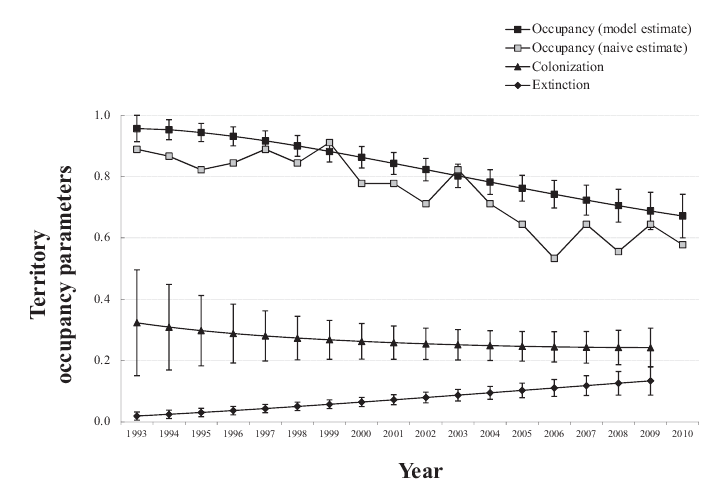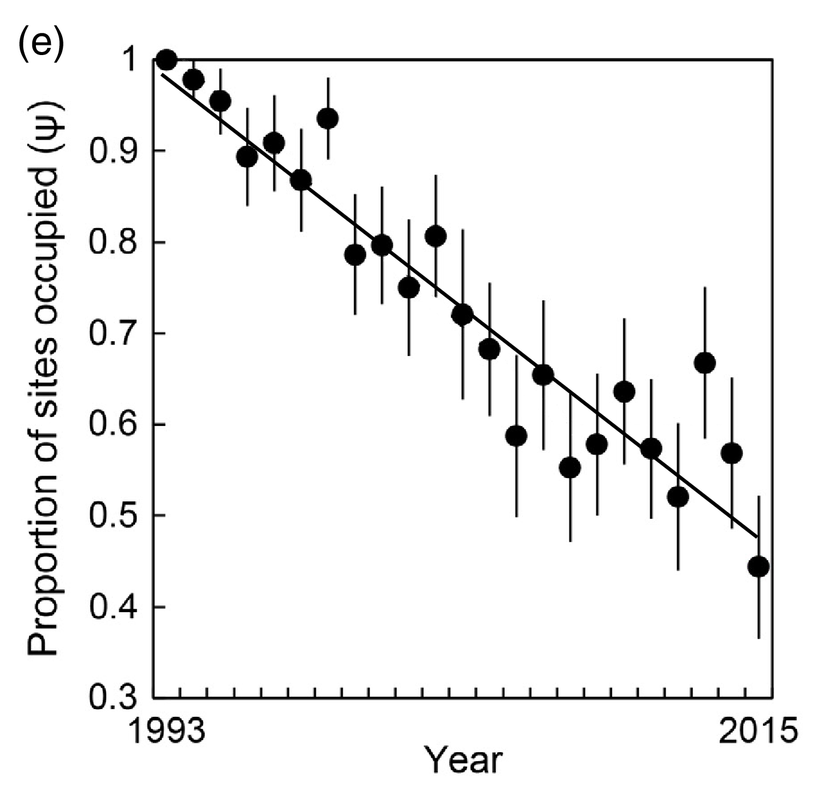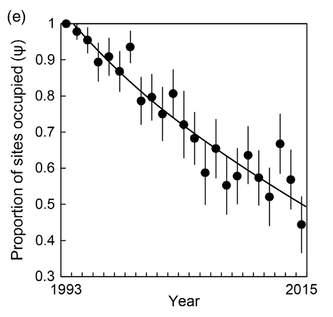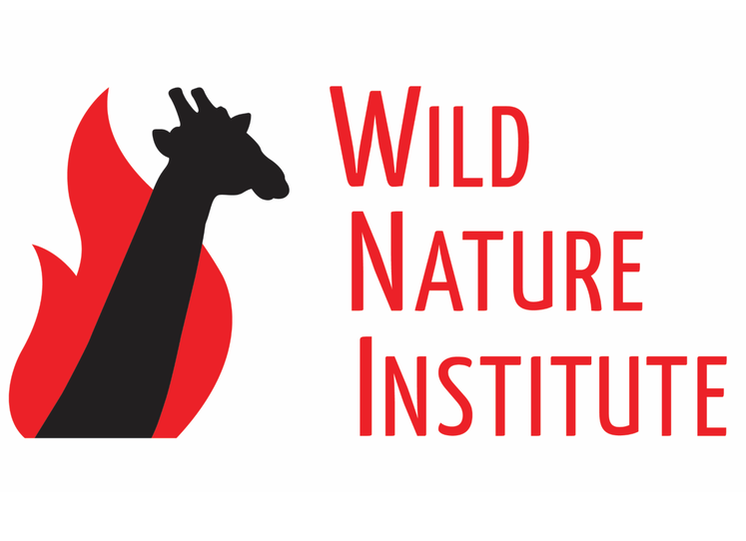|
(Post Updated Jan 2019.) A paper by Gavin Jones et al. "Megafires: an emerging threat to old-forest species" claims to describe negative effects of the 2014 King fire on California spotted owl occupancy and space use. There are several papers by other authors documenting how severe fire has little or no effect on spotted owl occupancy, and that they forage in high severity patches preferentially or in proportion to availability (Lee 2018). Jones et al. (2016) claim their data describe a strong negative impact of severe fire on spotted owls. The paper has fatal flaws in their analyses that render their results and discussion unreliable.
The population is in freefall, yet the authors compared their 1 year of post fire data against the mean of all previous years without accounting for the temporal trend in colonization and extinction. The observed long-term decline in annual site occupancy probability was the result of documented long-term trends of decreasing site colonization probability and increasing site extinction probability unassociated with fire (Tempel and Gutiérrez 2013). Jones et al. (2016) clearly described their method of partitioning their data into before-after and control-impact groups using only two dummy variables, and the first paragraph of their results and discussion compared estimates of extinction probability and occupancy probability from 2015 (one year post-fire) against the mean probability for all previous years. Clearly, Jones et al. (2016) did not account for the significant pre-fire temporal trends in colonization and extinction rates during their site occupancy analyses. This omission of temporal trends means their result for 2015 is due to the fact that this single year of post-fire data was the last year in the dataset, and should not be attributed unequivocally to the King fire. A simple linear trend of occupancy probabilities from 1993–2014 intersected the +1 SE error bar of the 2015 estimate (see below). This indicates that site occupancy in 2015 was not significantly different from the occupancy probability predicted for that year by the observed declining occupancy trend during the 22 pre-fire years. Jones et al. did a separate post-hoc analysis of trend in occupancy, but that was not included in the dynamic occupancy modelling. Including a pre-fire trend in the analysis would swamp the effect the authors attributed to fire. The temporal trend graphs Jones et al. should have presented and included in their dynamic occupancy analysis were the linear or quadratic trend (most likely the quadratic trend based on WebTable4)
Wildfire has more benefits than costs for spotted owl (Strix occidentalis) populations, according to a quantitative meta-analysis of forest wildfires, including “megafires” (Lee 2018). The best available summary of research on spotted owls and fire is Lee (2018)—the only systematic review and quantitative meta-analysis to date regarding spotted owls and mixed-severity fire (5–70% of burned area was comprised of high-severity fire patches with >75% mortality of dominant vegetation). Lee (2018) analyzed all studies of spotted owls (all three subspecies) in relation to mixed-severity fires that had not been subjected to post-fire logging. Fifteen papers reported 50 effects from fire that could be differentiated from post-fire logging. Meta-analysis of mean standardized effects (Hedge’s d) found only one parameter was significantly different from zero, a significant positive foraging habitat selection for low-severity burned forest. Multi-level mixed effects meta-regressions (hierarchical models) of Hedge’s d against percent of study area burned at high severity and time since fire found: a negative correlation of occupancy with time since fire; a positive effect on recruitment immediately after the fire, with the effect diminishing with time since fire; reproduction was positively correlated with the percent of high-severity fire in owl territories; and positive selection for foraging in low- and moderate-severity burned forest, with high-severity burned forest used in proportion to its availability, but not avoided. Spotted owls were usually not significantly affected by mixed-severity fire, as 83% of all studies and 60% of all effects found no significant impact of fire on mean owl parameters. It is important to clarify that instances of upwardly biased occupancy rates from false positives (e.g. Berigan et al. 2019) do not have any bearing on the effect size as analyzed in Lee (2018). False positives occur at all sites, regardless of level of burn severity (Berigan et al. reported no difference in false positive rates by burn severity), thus the effect size remains the same even if absolute occupancy rates might be upwardly biased. Contrary to current perceptions and recovery efforts for the spotted owl, mixed-severity fire does not appear to be a threat to owl populations; rather, wildfires as they have been burning in recent years appear to have more benefits than costs for spotted owls.
The Jones et al. study is one of only 3 examples of severe fire having a strong negative effect on spotted owls. The study was funded by the US Forest Service, and California Department of Forestry and Fire Protection, groups with a financial interest in promoting thinning logging of our forests in the name of protecting them from severe fire.
2 Comments
8/9/2016 08:37:49 am
Appalling and subjective comments in the abstract. Thank you for this analysis. "Almost all the owl territories within the megafire went from occupied to unoccupied," Duh, if there nest/roost tree burned to the ground, they moved to a nearby territory as Spotted Owls did after the McNally fire in 2002. What the McNally birds did not have to contend with was a patchwork of wholesale clearcuts in huge swaths of territory they did in the King Fire. http://blog.globalforestwatch.org/2014/09/map-king-fire-in-california-burns-areas-of-clearcuts-tree-plantations/
Reply
8/15/2016 04:17:51 pm
Jones et al made an unfounded logical leap from "fire is bad" to "logging is good." They also failed to consider the low probability of harm from fire, compared to the high probability of harm from logging. See Heiken, D. 2010. Log it to save it? The search for an ecological rationale for fuel reduction logging in Spotted Owl habitat. Oregon Wild. v 1.0. May 2010. http://dl.dropbox.com/u/47741/Heiken_Log_it_to_Save_it_v.1.0.pdf
Reply
Your comment will be posted after it is approved.
Leave a Reply. |
Science News and Updates From the Field from Wild Nature Institute.
All Photos on This Blog are Available as Frame-worthy Prints to Thank Our Generous Donors.
Email Us for Details of this Offer. Archives
July 2024
|
|
Mailing Address:
Wild Nature Institute PO Box 44 Weaverville, NC 28787 Phone: +1 415 763 0348 Email: [email protected] |
|




 RSS Feed
RSS Feed
